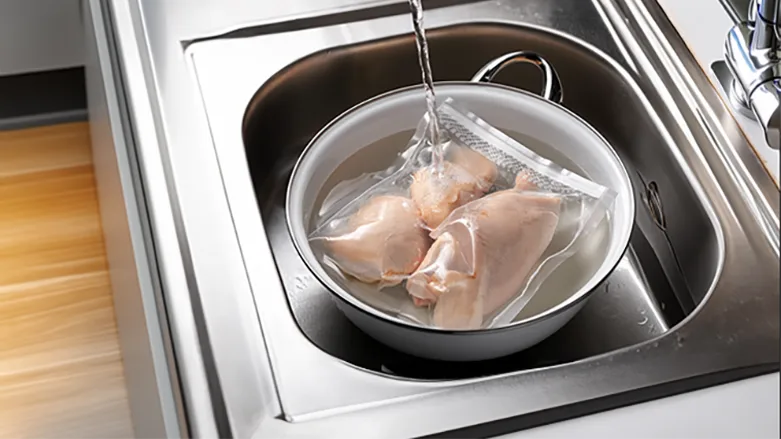If you’re gearing up for a big holiday dinner, one of the most important steps isn’t the seasoning or the stuffing—it’s thawing the turkey. You might not think much of it, but this single step could make or break your entire feast. Why? Because how you thaw your turkey affects both flavor and food safety.
So if you’re wondering whether it’s okay to leave that 20-pound bird out on the counter overnight, the answer is a hard no. Let’s dig into why that’s dangerous, what the experts actually recommend, and how you can get it right every time.
Why Safe Turkey Thawing Matters More Than You Think

When it comes to thawing poultry, it’s not just about convenience—it’s about protecting your family and guests from serious illness. Turkey, like all poultry, can harbor bacteria such as salmonella and campylobacter. These aren’t just food buzzwords—they’re bacteria that can lead to intense stomach pain, vomiting, fever, and worse.
Here’s the kicker: bacteria love temperatures between 40°F and 140°F, known as the “danger zone.” When your turkey sits in this range, even for a few hours, those bacteria multiply like wildfire.
Thawing it on the counter? That’s basically an open invitation for a bacterial block party.
The Dangers of Counter Thawing (And Why You Should Avoid It)
Let’s talk about what really happens when you leave your turkey out on the counter.
Even if the core of the turkey is still frozen solid, the outer layers start warming up pretty quickly. And once those outer layers hit the 40°F mark, they’re officially in the danger zone. That’s where bacteria start growing—fast.
Here’s what makes it worse: you can’t smell, see, or taste those bacteria. You might think you’ve cooked the bird thoroughly, but some toxins released by bacteria are heat-resistant. That means you could cook your turkey to the perfect golden-brown finish and still have a dish that puts everyone at risk.
Bottom line? Leaving a turkey out to thaw at room temperature is never safe. Not for an hour. Not overnight. Not ever.
Video : How to Thaw a Frozen Turkey
The Three Safe and USDA-Approved Ways to Thaw a Turkey
So what should you do instead? Thankfully, there are three reliable, expert-approved methods to thaw your turkey safely—each with its own pros and cons. Let’s break them down.
1. Refrigerator Thawing: The Gold Standard
If you want the safest and easiest option, stick that bird in the fridge.
- How it works: Place the turkey (still in its original packaging) on a tray or pan to catch drips. Keep it in the coldest part of your fridge.
- Time required: Allow 24 hours for every 4–5 pounds of turkey.
- Pros: Hands-off, safe, and reliable.
- Cons: Takes time, so it requires planning.
For example, a 20-pound turkey will take about 4 to 5 days to thaw in the fridge. But it’s worth it—you can then store the thawed turkey in the fridge for another day or two if needed.
2. Cold Water Thawing: Faster, But Demands Attention
Running short on time? This method is quicker—but you’ll need to stay on it.
- How it works: Keep the turkey in its sealed packaging and fully submerge it in cold water. Change the water every 30 minutes.
- Time required: About 30 minutes per pound.
- Pros: Much faster than fridge thawing.
- Cons: Requires constant monitoring and clean water.
Let’s say you have a 16-pound bird. That’s about 8 hours of soaking—and changing the water 16 times. It’s a commitment, but it’s safe if done properly.

3. Microwave Thawing: Quickest, But Not for Big Birds
This method is only viable for smaller turkeys, and only if your microwave is big enough.
- How it works: Remove all packaging and follow your microwave’s thawing instructions (usually based on weight).
- Time required: Varies—check your microwave manual.
- Important: Cook the turkey immediately after thawing.
- Pros: Fastest method.
- Cons: Uneven thawing, limited to small turkeys, must cook right after.
If your microwave can’t rotate or the turkey is too big to fit, skip this method entirely.
What Food Safety Experts Say About Turkey Thawing
Experts from the USDA and Centers for Disease Control and Prevention (CDC) are crystal clear: never thaw your turkey at room temperature. The risks of foodborne illness are just too high. Even in cold weather, indoor temps can hover around 65–70°F—still well within the danger zone for bacteria.
They recommend only the refrigerator, cold water, or microwave methods. These strategies ensure your turkey stays out of the danger zone, giving you peace of mind and a healthy holiday.
Video : How to Defrost Meat Quickly & Safely
Debunking Popular Turkey Thawing Myths
Let’s squash a few common misconceptions before they get passed down another generation:
- “It’s winter, the house is cold—leaving it out overnight is fine.” Nope. Indoor air is still warmer than you think. Even in a chilly house, the turkey’s outer layers hit dangerous temps quickly.
- “I’ll cook it thoroughly, so it’s safe anyway.” Not necessarily. Cooking can kill bacteria, but heat-resistant toxins may still linger if bacteria had time to grow.
- “It’s how my grandma did it, and we never got sick.” You might’ve gotten lucky—but with what we know now, there’s no excuse to risk it.
Conclusion: Plan Ahead, Stay Safe, and Enjoy the Feast
Here’s the truth: thawing a turkey isn’t glamorous, but it’s one of the most important steps of your holiday meal. It can mean the difference between a celebration and a health emergency.
Don’t let old habits or last-minute stress lead you to unsafe choices. Use the refrigerator if you have time, opt for the cold water method if you’re in a hurry, or use the microwave with caution. But whatever you do—don’t leave your turkey out on the counter.
With a little planning and the right method, you’ll serve up a turkey that’s not just juicy and golden, but completely safe for everyone at your table.


